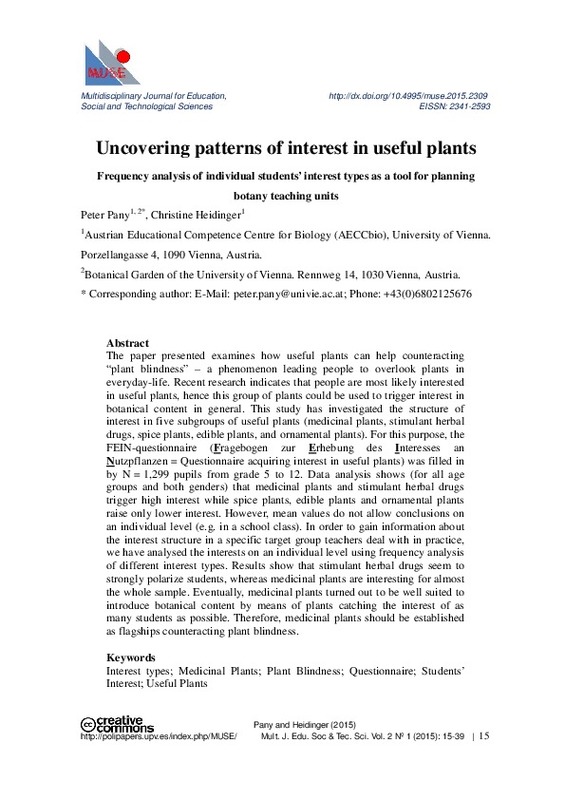JavaScript is disabled for your browser. Some features of this site may not work without it.
Buscar en RiuNet
Listar
Mi cuenta
Estadísticas
Ayuda RiuNet
Admin. UPV
Uncovering patterns of interest in useful plants. Frequency analysis of individual students’ interest types as a tool for planning botany teaching units
Mostrar el registro sencillo del ítem
Ficheros en el ítem
| dc.contributor.author | Pany, Peter
|
es_ES |
| dc.contributor.author | Heidinger, Christine
|
es_ES |
| dc.date.accessioned | 2017-01-16T10:44:04Z | |
| dc.date.available | 2017-01-16T10:44:04Z | |
| dc.date.issued | 2015-01-12 | |
| dc.identifier.uri | http://hdl.handle.net/10251/76829 | |
| dc.description.abstract | [EN] The paper presented examines how useful plants can help counteracting “plant blindness” – a phenomenon leading people to overlook plants in everyday-life. Recent research indicates that people are most likely interested in useful plants, hence this group of plants could be used to trigger interest in botanical content in general. This study has investigated the structure of interest in five subgroups of useful plants (medicinal plants, stimulant herbal drugs, spice plants, edible plants, and ornamental plants). For this purpose, the FEIN-questionnaire (Fragebogen zur Erhebung des Interesses an Nutzpflanzen = Questionnaire acquiring interest in useful plants) was filled in by N = 1299 pupils from grade 5 to 12. Data analysis shows (for all age groups and both genders) that medicinal plants and stimulant herbal drugs trigger high interest while spice plants, edible plants and ornamental plants raise only lower interest. However, mean values do not allow conclusions on individual level (e.g. in a school class). In order to gain information about the interest structure in a specific target group teachers deal with in practice, we have analysed the interests on individual level using frequency analysis of different interest types. Results show that stimulant herbal drugs seem to strongly polarize students, whereas medicinal plants are interesting for almost the whole sample. Eventually, medicinal plants turned out to be well suited to introduce botanical content by means of plants catching the interest of as many students as possible. Therefore, medicinal plants should be established as flagships counteracting plant blindness. | es_ES |
| dc.language | Inglés | es_ES |
| dc.publisher | Universitat Politècnica de València | |
| dc.relation.ispartof | Multidisciplinary Journal for Education, Social and Technological Sciences | |
| dc.rights | Reconocimiento - No comercial - Sin obra derivada (by-nc-nd) | es_ES |
| dc.subject | Interest types | es_ES |
| dc.subject | Medicinal Plants | es_ES |
| dc.subject | Plant Blindness | es_ES |
| dc.subject | Questionnaire | es_ES |
| dc.subject | Students’ Interest | es_ES |
| dc.subject | Teaching botany | es_ES |
| dc.subject | Useful Plants | es_ES |
| dc.title | Uncovering patterns of interest in useful plants. Frequency analysis of individual students’ interest types as a tool for planning botany teaching units | es_ES |
| dc.type | Artículo | es_ES |
| dc.date.updated | 2017-01-16T10:29:28Z | |
| dc.identifier.doi | 10.4995/muse.2015.2309 | |
| dc.rights.accessRights | Abierto | es_ES |
| dc.description.bibliographicCitation | Pany, P.; Heidinger, C. (2015). Uncovering patterns of interest in useful plants. Frequency analysis of individual students’ interest types as a tool for planning botany teaching units. Multidisciplinary Journal for Education, Social and Technological Sciences. 2(1):15-39. https://doi.org/10.4995/muse.2015.2309 | es_ES |
| dc.description.accrualMethod | SWORD | es_ES |
| dc.relation.publisherversion | https://doi.org/10.4995/muse.2015.2309 | es_ES |
| dc.description.upvformatpinicio | 15 | es_ES |
| dc.description.upvformatpfin | 39 | es_ES |
| dc.type.version | info:eu-repo/semantics/publishedVersion | es_ES |
| dc.description.volume | 2 | |
| dc.description.issue | 1 | |
| dc.identifier.eissn | 2341-2593 |








